PHENOMENON
hassan muzzafar haq
October 1st, 2023
Chasing Absolute Zero: The Quest to Understand the Coldest Temperature in the Universe
What is the coldest recorded temperature? When reading a statement like this, you might be left pondering more questions than answers. After all, how could a query so vague and broad have a definite answer? How would we even discover that answer? How would we know the limit anyway? Although your skepticism is warranted, in the quest to unravel the mysteries of the cosmos, scientists and astrophysicists already have an answer, albeit largely a theoretical one.
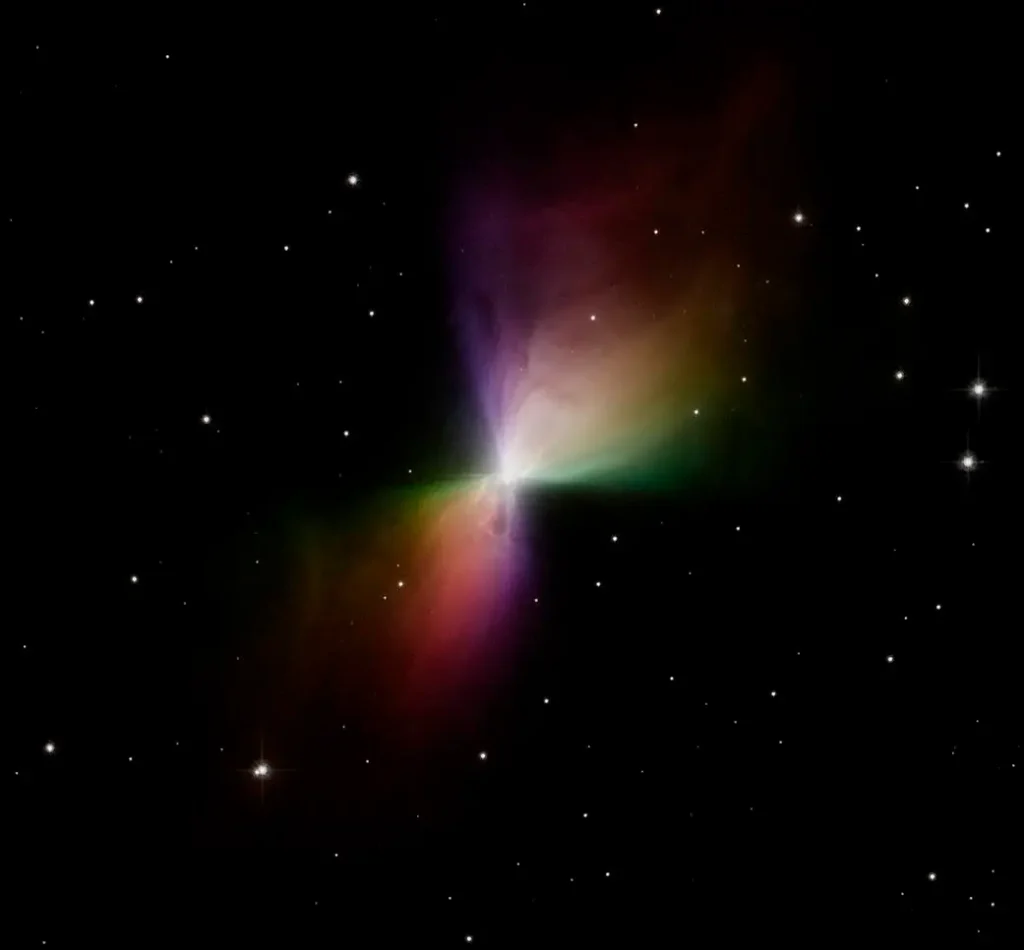
A mesmerizing image of the Boomerang Nebula, captured by the Hubble Space Telescope with its Advanced Camera for Surveys, reveals this celestial wonder located about 5,000 light years away. Notably, the Boomerang Nebula's temperature approaches absolute zero. Image Credit: NASA, ESA, and The Hubble Heritage Team (STScI/AURA)
The universe is a vast and ominous place, filled with extremes beyond our imagination. Among these extremes, one of the most intriguing is the concept of absolute zero, the coldest temperature possible in the universe. From the scorching heat of the desert to the chilling depths of outer space, temperature serves as a crucial yardstick by which we measure the boundaries of our physical world. On our blue planet itself, the lowest temperature typically ranges around -128 degrees Fahrenheit (-89 degrees Celsius) to -130 degrees Fahrenheit (-90 degrees Celsius). These frigid temperatures are found in locations like Antarctica, Siberia, and the high-altitude plateaus of Antarctica. They are extremely cold by human standards and can cause frostbite and hypothermia within minutes of exposure.
Then there is Absolute Zero, the denotation given to the coldest possible condition in the entire universe. It is the point at which particles in a substance have the minimum possible thermal energy, and as a result, their temperature cannot be lowered any further. At this level, the motion of atoms and molecules comes to a standstill, and entropy, a measure of disorder in a system, reaches its least possible value.
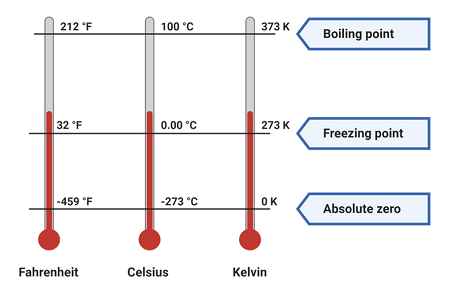
Comparison Chart of Absolute Zero in Various Temperature Units/Measurements Photo Credit:(Study.com)
The concept of absolute zero is a fundamental principle in thermodynamics, a branch of physics that deals with heat, energy, and temperature. It was first theorized by French physicist Guillaume Amontons in the early 18th century and later refined by Lord Kelvin (William Thomson) in the mid-19th century, leading to the Kelvin temperature scale. On this scale, Absolute Zero represents the base minimal value of 0 Kelvin (0 K), translating to -273.15 degrees Celsius or -459.67 degrees Fahrenheit.
The notion itself is mostly theoretical, as reaching such a temperature practically is near impossible for macroscopic objects (objects visible to the naked eye). However, scientists from various fields have made significant progress in cooling matter to temperatures that come remarkably close to absolute zero, utilizing a number of techniques made possible by our advancements in technology. One such method is laser cooling, in which laser beams are used to slow down and cool atoms, based on the interaction between the laser light and particles being cooled. It works on the following principles:
Absorption and Emission of Photons
Atoms or molecules have discrete energy levels. When laser light of a specific frequency (wavelength) is directed at these particles, they can absorb photons (particles of light) and transition to higher energy levels. However, the atoms or molecules quickly return to their original energy state by emitting a photon of the same energy. This emission process is called spontaneous emission.
Doppler Shift
Laser cooling relies on the Doppler effect, which occurs when atoms or molecules are moving relative to the source of the laser light. The Doppler effect causes a shift in the frequency of light seen by moving objects. If an atom is moving toward a laser beam, it will experience a slightly higher frequency of light (blue-shifted), and if it's moving away, it will experience a slightly lower frequency (red-shifted).
Selective Absorption
Laser cooling takes advantage of the Doppler effect by using lasers with carefully tuned frequencies. These lasers are detuned slightly below the transition frequency between two atomic energy levels. Atoms moving toward the laser will be closer to resonance with the laser light, so they are more likely to absorb photons, while atoms moving away from the laser are less likely to absorb photons.
Momentum Exchange
When an atom absorbs a photon and moves to a higher energy state, it gains momentum from the absorbed photon. Conversely, when it spontaneously emits a photon and returns to a lower energy state, it loses momentum. This momentum exchange leads to a net cooling effect, slowing down the atoms or molecules.
Repetition and Trapping
The process is repeated with many atoms or molecules, causing them to lose kinetic energy and slow down. The particles can be further cooled and trapped using additional lasers, magnetic fields, or electromagnetic traps.
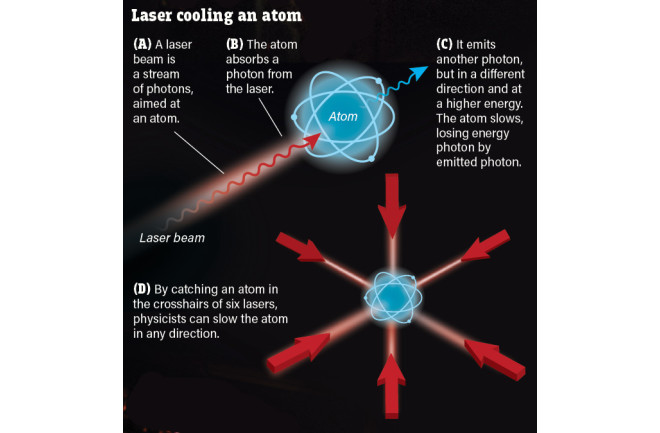
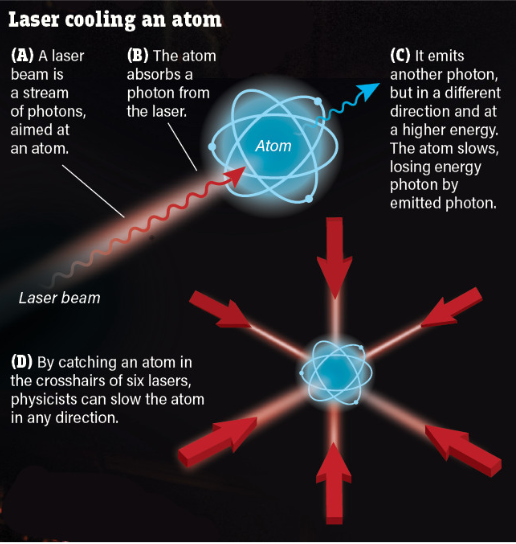
This technique, first used in the 1970s, is called laser cooling (Credit: Alison Mackey/Discover)
Quite complicated, isn't it? You might wonder why knowing Absolute Zero is even helpful, why go through so much effort to understand it further? There are many reasons, relating to a variety of benefits to researchers and experts across numerous areas of science and engineering. One such advantage is that it aids in our current understanding of thermodynamics, as it serves as a prime reference point on the Kelvin scale. This scale is essential for studying and describing the behavior of gasses, liquids, and solids under different temperature conditions. It assists in making scientists understand concepts such as heat transfer, phase transitions, and energy transformations.
Another discipline where it is a major support is Cryogenics, which is specifically the study of low temperatures. As one can imagine, Absolute zero is of utmost importance in this field. Scientists and engineers use this knowledge to develop technologies that involve the storage and manipulation of materials at ultra-cold temperatures. Applications of cryogenics include medical imaging (MRI machines), superconductors, and the study of matter at low temperatures.
The phenomena of absolute zero also have a place in quantum physics, providing insights into the fundamental behavior of matter. As temperatures approach 0 K, unusual and intriguing phenomena occur, such as the formation of Bose-Einstein condensates, where particles behave as a single quantum entity. This has led to discoveries in quantum physics and the development of new materials and technologies. Furthermore, in space exploration, understanding the behavior of materials at extremely low temperatures is critical. The vacuum of space allows temperatures to drop significantly, and knowledge of absolute zero helps scientists design spacecraft and instruments that can withstand these conditions, better preparing us for the uncharted expanses lying in the great void.
High-energy physics also gains improvement from awareness of 0 Kelvin: In particle accelerators like the Large Hadron Collider (LHC), particles are surged to nearly the speed of light and collide, generating extremely high temperatures. Knowledge of absolute zero helps physicists understand and manipulate the energy levels involved in these experiments. Absolute Zero also plays a role in material science as it allows specialists to study the properties of materials and how they are altered at low temperatures. This is particularly important in the development of advanced materials with unique properties, such as superconductors, which can carry electric current with zero resistance at very cold temperatures. It is also considered prevalent in facilitating the progress of quantum computing tech. In view of this information, it can be derived that Absolute Zero underpins a myriad of scientific subjects.
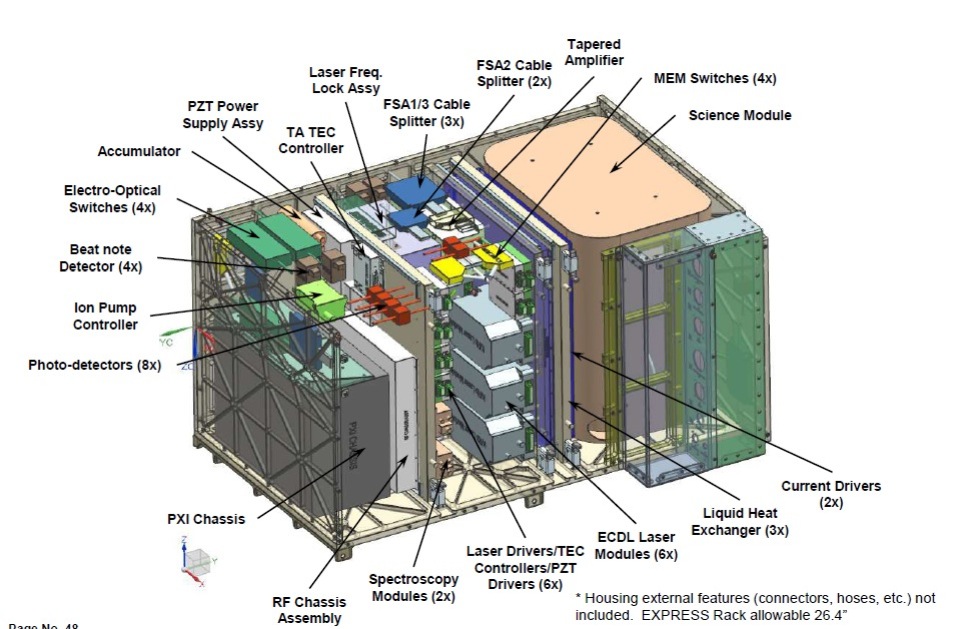
The image showcases the Cold Atom Lab (CAL) on the International Space Station (ISS), a cutting-edge laboratory that studies ultra-cold temperatures using advanced cooling methods cooling, to advance fundamental physics, quantum mechanics, and materials science (Image Credit: NASA)
Finally, what are some spots in the universe where temperatures can fall close to 0 Kelvin? Here is a list of examples:
The Boomerang Nebula
Located in the constellation Centaurus is considered one of the chilliest places in the universe. Its temperature hovers around just one degree above absolute zero. The frigid conditions here are the result of a dying star ejecting gas and dust into space.
The Cold Atom Laboratory
Operated by NASA on the International Space Station, the Cold Atom Laboratory uses advanced cooling techniques (such as the aforementioned Laser cooling) to create a microgravity environment where temperatures close to absolute zero can be achieved. Experiments and tests are conducted
Cosmic Microwave Background Radiation
The remnants of the Big Bang, known as the cosmic microwave background radiation, permeate the universe at temperatures of approximately 2.7 Kelvin, which is only a few degrees above absolute zero. These faint, frosty microwaves provide crucial insights into the early universe's conditions.
High-energy physics also gains improvement from awareness of 0 Kelvin: In particle accelerators like the Large Hadron Collider (LHC), particles are surged to nearly the speed of light and collide, generating extremely high temperatures. Knowledge of absolute zero helps physicists understand and manipulate the energy levels involved in these experiments. Absolute Zero also plays a role in material science as it allows specialists to study the properties of materials and how they are altered at low temperatures. This is particularly important in the development of advanced materials with unique properties, such as superconductors, which can carry electric current with zero resistance at very cold temperatures. It is also considered prevalent in facilitating the progress of quantum computing tech. In view of this information, it can be derived that Absolute Zero underpins a myriad of scientific subjects.
In conclusion, the coldest temperature in the universe, absolute zero, is a concept that has intrigued scientists and astrophysicists for centuries. While we cannot reach absolute zero for macroscopic objects, we have made remarkable progress in cooling matter to temperatures that come incredibly close. Learning about such fantastical phenomena widens our scope of imagination, stimulating the curious components of our minds while promoting a passion for discovery and skills surrounding objective analysis. I hope this article has stoked your curiosity and given you more to think about regarding our cosmos, thawing that need to unearth more about nature that often remains frozen in our thoughts. As Albert Einstein once said,
“The important thing is to never stop questioning, curiosity has its own reason for existing.”
Subscribe To Our Newsletter
Receive amazing space news and stories that are hot off the press and ready to be read by thousands of people all around the world.
